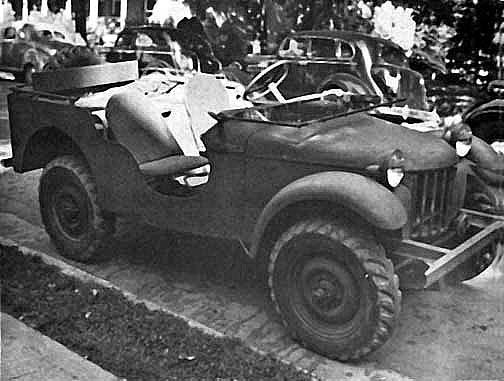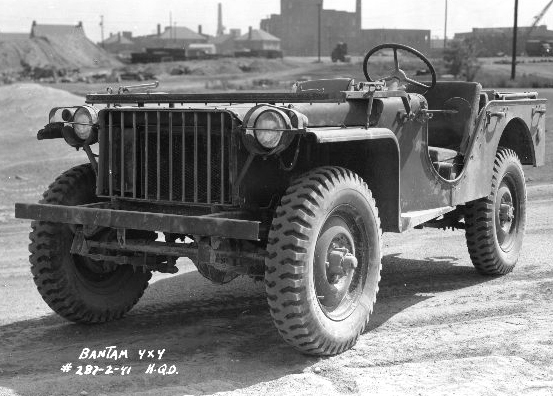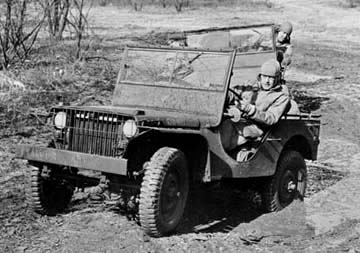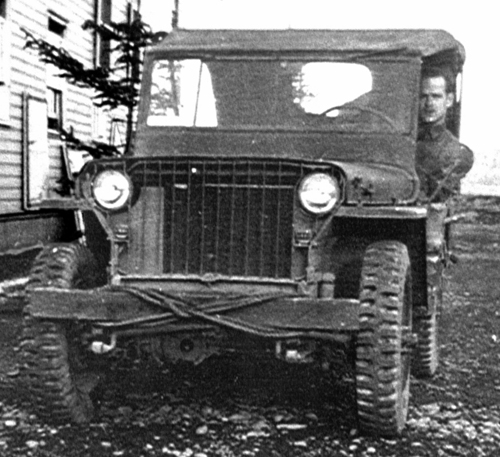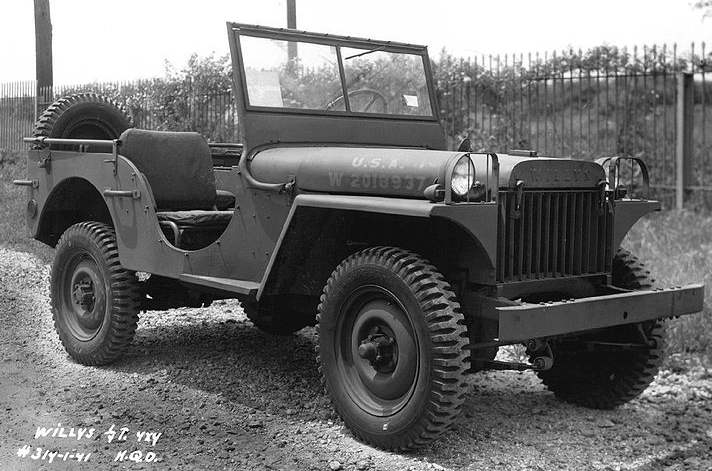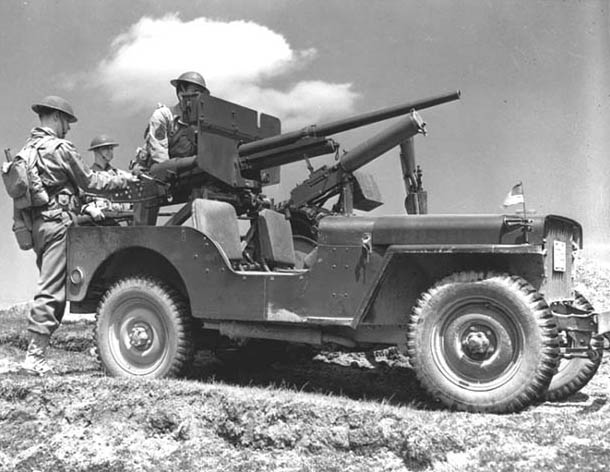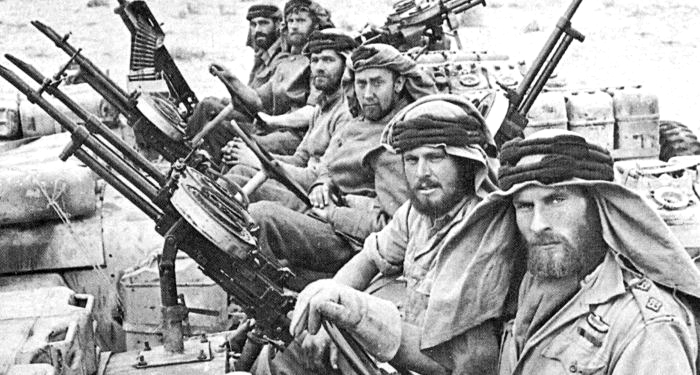Willys MB/Ford GPW Jeep
 General purpose vehicle (1941-45)
General purpose vehicle (1941-45)
USA - about 650,000 built
An American myth
The vehicle universally known as the "Jeep" is more than a simple military vehicle. It has all the characteristics of a mechanized legend, with few competitors worldwide, except, perhaps, for the German Volkswagen Beetle and its Kübelwagen derivative. In 1991 it was labelled an "International Historic Mechanical Engineering Landmark" by the American Society of Mechanical Engineers. In postwar years, the Jeep inspired the civilian 4x4 concept, and was copied all around the world, with nearly a million built, by 1968, in the USA alone.
The army truck, 1/4 ton, 4x4
All started when war in Europe seemed imminent. The United States Department of War looked to replace older vehicles still in use with a new specially-built 4x4 light cross-country reconnaissance and utility vehicle. This effort had started for some time, in 1937-38, and several companies delivered prototypes, like the Marmon-Herrington based on a Ford 1/2 ton truck, the Austin or American Bantam. Only on June, 11th, 1940 were the specifications made official and delivered to 136 American manufacturers. It asked for a "(...) general purpose, personnel, or cargo carrier especially adaptable for reconnaissance or command, and designated as 1/4-ton 4x4 Truck."
The bids had to be delivered to the Army's Ordnance Technical Committee in only ten days (the 22nd of June). Moreover, the urge was so great that the companies had to present their first prototype within 49 days, and be ready to deliver 70 more pre-series test vehicles in 75 days. The specifications asked for a four-wheel drive, 75 in (1.9 m) wheelbase/ 47 in (1.2 m) track vehicle, with a crew of three, 300 kg (660 lbs) payload, a folding windshield, and a 85 ft/lbs (115 J) torque-capable engine. Moreover, it had to be kept within the strict limit of 1,300 lbs (590 kg). Needless to say, the combination of such demands within such a short time was deemed impossible and declined by all companies but two: Willys-Overland & American Bantam.
The 1940 Bantam prototype
Indeed, as daunting as it was, the prospect of earning a huge army contract motivated Roy Evans, who was the head of American Bantam since 1935. He had previously saved the company from bankruptcy. In 1940, the prospects were still quite meager for the small company. He contacted an experienced designer, Karl Probst, and finally answered the bid, within the time frame, with the "Blitz Buggy", after an exhausting day-and-night technical and mechanical marathon. Willys-Overland was the lowest bidder (promising $748.74 per unit), but was found unable to guarantee the pilot and test models on time. Therefore, Bantam was chosen at first by the Army commission, which tested the "Blitz Buggy" at Camp Holabird, Maryland, on 23rd September 1940. Bantam also delivered the promised seventy BRC-60s for extensive tests.
However, the financial and technical aspects of massive wartime production were something the commission could not ignore. Soon, Ford and Willys were both asked to deliver their prototypes anyway (receiving Bantam's original blueprints, freshly acquired by the army). Other tests were performed at the same location with the three vehicles in November. Under pressure of the hierarchy, and finding that the three models (Willys Quad, Ford Pygmy and the new Bantam BRC 60) were strongly similar, the commission eventually awarded a 1500-units contract to each company, while the weight limits were raised to a more reasonable 2,160 lbs (980 kg).
While all three companies started production, and the first models arrived for testing in the US Army, the commission still had to decide to give the mass-production contract to a single company. Willys-Overland won the contract, mostly because the Go-Devil engine gave by far the most impressive performances, as stated in numerous field reports. The cost was also a concern, as well as a lower silhouette.
Design
The three were open-top vehicles, although a tarpaulin could be fitted to the windshield, held in place by two folding tender bars over the cargo bay. This cargo bay comprised a rear seating bank, and there were two front bucket seats. The suspensions were independent, but leaf-sprung. The cargo bay covered the rear wheels, while the front ones had mudguards of different shapes, like did the side openings used to access the driver compartment. For better rigidity and mass production simplification, there were no doors. The same reasoning was applied to the front, which had a flat radiator grille, which also covered the main headlights. All these points could help distinguish between the factory models.
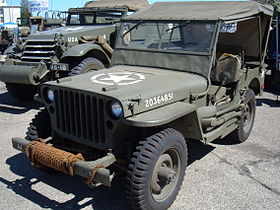
The Jeep also received 6 x 16 tires, a spare wheel and gas jerrycan at the rear, provisions for trailer lights, but also spark interference suppression, blackout light system (which could be hinged up to illuminate the engine compartment by night), as well as sealed spring shackles. Most also received folding top bows, used to hold in place a waterproof canvas with plastic windows, usually stored in a dedicated compartment. It was attached to the top windshield bar. The hull also received exterior handles for manual extrication of muddy terrain. There were also large bumperettes. The instrument panel was military, with black faced oil pressure, ammeter, fuel level, water temperature and speedometer gauges. On the original Bantam, differential and transfer case levers were found at the left of the transmission lever. In production models, these were placed at the right. A sturdy pintle mount base was also welded on the floor, just between the two front bucket seats, which could handle any kind of ordnance machine guns, and even a twin bazooka mount. The standard pintle mount was capable of a near-vertical elevation for AA fire. This gave the Jeeps fitted with M1920 cal.50 (12.7 mm) anti-aircraft capabilities at company level. The original stamped and welded roadwheels were also gradually replaced by bolted combat wheels, easier to replace.
Willys MA
The Willys Quad was very similar in dimensions and features to the others, but completely outperformed them in one area. The Go-Devil engine developed by Delmar "Barney" Roos, giving 60 horsepower, 105 foot-pounds of torque, compared to Bantam 83 and Ford 85. The "Quad" was refined and simplified, ending as the first production version, Wyllis MA. A total of 16,000 vehicles had to be supplied to the army, starting in June 1941. "MA" means "Military", model "A". Eventually, Willys would deliver 1553 MA models until the end of 1941. In 1942 the production was shifted to the simplified MB.
Willys MB
The Willys MB was the mass-production version, modified according to army field operation reports and simplifications in design. The most obvious change was the front radiator grille. It was, for the 25,000 initial deliveries, a welded flat iron "slat", later replaced by the familiar and simpler stamped, slotted steel grille, originally a Ford design. According to factory designation, this model was renamed "B" (MB). Eventually, Willys will produce 361,339 Jeeps until the end of the war, including 25,808 of the slat radiator grille model, and 335,531 with the stamped steel grille. The MB retained the MA windshield design for some time, before swapping to a new model.
Ford GP/GPW model
By October 1941, it was already clear that Willys-Overland couldn't keep the pace of deliveries, and Ford was contacted. Ford delivered 280,000 Ford GPs, alongside an amphibious model, the GPA. 4456 GPs derived from the Ford Pygmy were built in 1941, followed by 277,896 improved GPWs, derived from the Willys design. GPW means "Government", "P" being the usual factory letter for passenger cars with a 80 inch wheelbase, and "W" to signify it was a Willys licensed design. Since regular soldiers preferred the Willys model, many Ford GPWs were part of the Lend-Lease program. No less than 15,000 of these were delivered to the Soviets.
Origins of "Jeep" name
At least several theories exist, but anyway, the original army designation was too long to be used in everyday soldier talk. It was perhaps the bastardization of "General Purpose", "GP". Anyway, it started as a nickname and had a life of itself, surviving the original manufacturers. On military test bases, mechanics usually called untested models "Jeep". When the first preseries vehicles arrived in garrison, the impression was such that common soldiers started to use the nickname in reference to "Eugene the Jeep", Popeye's lightning fast and resourceful pet companion, from the popular comic strip created by E. C. Segar in 1936. Later on, a press demonstration was organized at the marches of the capitol by Willys Overland, and the test driver, Irving "Red" Haussmann, hearing soldiers repeatedly giving the vehicle this nickname at Camp Holabird, also used it when interviewed by the Washington Daily News. It spread like a bonfire.
Variants and derivatives
The incredible versatility of this vehicle, deeply rooted in the Army's original specifications, made it the perfect go-anywhere, do-anything of all infantry divisions and most services of the Army. It was everywhere and used for any conceivable task, often transformed in the field. Since regulations and "kits" were largely distributed among units by the Army, some Jeeps ended with several configurations during their active life, which spanned -for some models- nearly forty years before joining the civilian market. Such was the reliability and sturdiness of the package.
Personal carrier
As delivered, most Jeeps were serviceable for this task, without armament. They could accommodate three passengers, plus the driver.
Scout/Recce
The most frequent combination encountered in the field. They were fitted with medium-range radios, and armed with the M1919 air-cooled Browning placed on the central pintle mount (fired by a standing gunner), but in some occasions, a heavier M1917A1 liquid-cooled was placed above the engine hood and fired by the co-driver. The M1920 often replaced the M1919 for added firepower. Usually the crew was two or three, the spare seat being utilized for ammo racks and gasoline jerrycans, allowing extra range. In practice, a large blackout headlamp was also mounted on the left front fender.
Antitank Jeep
The speed, small size and off-road capabilities of the Jeep made it an excellent "tank killer" when acting as a "skirmisher" at short range. In general, a specially tailored twin-bazooka encasing was fitted on the central pintle mount. It was not standard practice however. A recoilless gun was also tried after the war.
Armored Jeep
In reconnaissance operations, the Jeep proved fast, but clearly unprotected. This led to field adaptation of armored plates and, after some time, formulated and officialized as the "1/4 ton 4x4 armored truck". This was an attempt by the army to set regulations of field modifications, consisting of adding a kind of "armored box" made of three plates (actually a single plate folded in three) protecting the front and sides of the driver compartment, with two small sight openings. The front plate replaced the windshield. The protection was sufficient against small arms fire.
Ambulance
It could be said that the Jeep saved countless GI lives on the frontline. Many were hastily converted on the field, but after some time, the regulations, again, dictated a "kit" to be fitted. In this configuration, the Jeep carried three stretchers on a welded frame, held in position in the cabin, and overhanging by 1 meter to the front.
Weather vehicle
These special vehicles were used by HQ auxiliary services, using a twenty foot tall meteo antenna with wind, pressure and humidity receptors, and a long range radio and generator which occupied the cargo bay.
Radio vehicle
Although most Jeeps received medium and short range radios, for long range advanced patrols, the cargo bay received a long range radio and generator. Like the weather vehicle, it was unarmed, except for the small arms of the driver and radio operator.
Tractor/Supply vehicle
Jeeps were fitted with a hook for a trailer, the ordnance two-wheeled "Trailer, 1/4-ton, 2W, cargo, Amphibian", which had a splayed cross-section, and a tarpaulin. The main models were the K38 and K-38A, used by the US Army Signal Corps. The postwar models were the M100 and M416 trailers. The K38 could be distinguished by the use of curved mudguards. As a tractor, the usual loads consisted in the US M2 60 mm (2.36 in) or M1 81 mm (3.19 in) mortars, the Howitzer, Pack, 75 mm (2.95 in) M1 on Carriage M1, and the standard 37 mm (1.46 in) Gun M3 on Carriage M4.
Ford GPA
i
This was an amphibious version of the Jeep, designed by Ford in 1942, somewhat fueled by the success of the
DUKW. It was also called the "Seep" (contraction of "Sea" and "Jeep"), and was in fact a Jeep wrapped by a waterproof hull, overhanging front and rear. It was rushed in production in 1942 and criticized for its shortcomings, namely a low freeboard, which proved highly problematic, combined with a much heavier weight than the original Jeep (3520 vs 2640 lbs/1596 vs 1140 kg). It was unable to carry a significant cargo load and therefore was mostly used as personnel carrier. It was often found that the vehicle could simply sink in shallow waters, if there were any waves, and it was slow, anemic and unwieldy on land. The crews simply despised this model. Eventually, most were shipped to the USSR via Lend-Lease, and the production was stopped in March 1943 after 12,778 vehicles had been delivered.
The Jeep in action
About 144 Jeeps were provided to every infantry regiment in the U.S. Army, so it was the most currently available vehicle. This explains why it was used for so many tasks and so extensively, marking a deep and durable imprint on simple soldiers. Since it was involved in every possible operations performed by the US Army and Marines in Europe, Africa and the Pacific, it would be pointless to detail specific assignations. It was used as personnel carrier, staff transportation, medevac, liaison, reconnaissance, patrol, spearheading advanced columns or deep into enemy territory. It was used as light artillery tractor, ammo, water, food, fuel supply vehicle, mortar tractor, infantry support vehicle and even fast antitank vehicle, armored and equipped with bazookas. 30% of the production, mostly Ford GPAs, were turned to the Lend-Lease effort, largely distributed among British & Commonwealth, Free French, Free Polish forces and the Soviets, which ultimately derived a vehicle from it, the GAZ-67B. The production of this Soviet version started in September 23, 1943, and lasted until 1953, after 92,843 had been delivered.
One of the most thrilling uses of the Jeep, was performed by British and Allied LRDG units, "Long Range Desert Group" in North Africa. Often paired with Chevrolet WB trucks, they were heavily armed and received a lot of extra fuel. Their task was to navigate deep and far into enemy territory, gathering intelligence and operating covert reconnaissance. But they also hit depots, camps or even airbases, sometime at night or dawn, striking hard and fast, and creating havoc in rear line sectors reputedly "quiet", and therefore weakly defended. They made such an impression on the Italians in particular (which called it the "Pattuglia Fantasma" or "Ghost Patrol") that they developed a special vehicle, the AS-42 Sahariana, derived from the
AB-41 armored car for the same tasks and missions.
Postwar career & legacy
The Willys M38 was the immediate postwar continuation of the original Jeep, also known as the Willys MC. Produced to 61,423 units from 1950 to 1952, and replaced by the M38A1/Willys MD (1952-57 and 101,488 units), Willys M606 in 1954-64 (6500), and the M606 until 1968 with 155,500 vehicles. So that, in 1970, when a replacement was first sought, the "Jeep" production culminated to a staggering 972,830 vehicles -almost a million. It was also largely produced under licence during the postwar by many NATO and non-aligned countries, many of which are still in use. It was replaced in the eighties by the Humvee. Its civil career was also brilliant, as the discharged GI\'s started buying surplus vehicles at such a rate that Willys sold thousands more of the "CJ", the MB civilian version. There was, for some time, a brand battle around the name of "Jeep", that eventually Willys inherited after Bantam went bankrupt in 1955. "Jeep" has, in the meantime, became a standalone brand and inspired Land Rover, Toyota, Nissan, Mitsubishi, Suzuki to produce off-road vehicles, thus leading to the actual branch of SUVs.
Links about the Jeep
The Willys MB on Wikipedia
Kaiser Willys, Jeep parts and accessories
Willys MB 1941 specifications |
| Dimensions (L-w-h) |
3.32 x 1.57 x 1.83 m (131 x 62 x 72 in) |
| Wheelbase |
203 cm (80 in) |
| Curb weight, battle ready |
1040 kg (2293 lbs) |
| Crew |
1+3 (driver +3 passengers) |
| Propulsion |
Go Devil I4, 134 cu in (2.2 l), 60 hp |
| Transmission |
3-speed manual 2 reverse, 2-speed Dana-18 transfer case |
| Top speed |
110 km/h (65 mph) road, 50 km/h (29 mph) off-road |
| Maximum range |
458 km (285 mi) |
| Armament |
None |
| Armor |
Maximum 6 mm (0.2 in) if armoured |
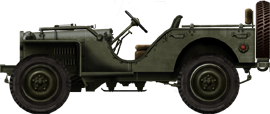
Bantam BRC-40, the original Jeep of 1940.
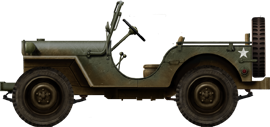
Willys Jeep MA, early production.
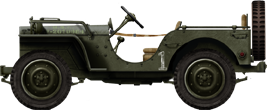
An early Ford GP in China, Flying Tigers Squadron, 1941.
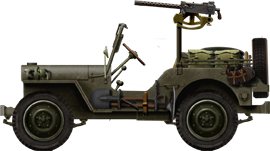
Standard Willys MB with a cal.30 (7.62 mm) machine-gun. High quality illustration.
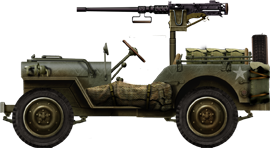
Willys MB with a cal.50 (12.7 mm) machine-gun, the heaviest weapon fitted regularly on the Jeep.
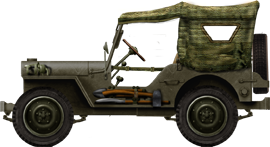
Standard Willys MB Jeep with tarpaulin.
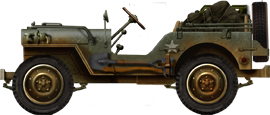
A Willys MB from the 1st Infantry Division, Operation Torch, November 1942.
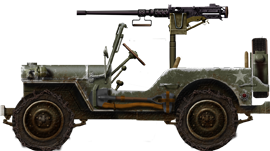
Willys MB Jeep, Belgian Ardennes, Battle of the Bulge, December 1944.
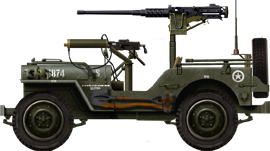
Willys fitted with radio and Browning M1917A1 liquid-cooled machine gun (7.62 mm/0.3 in) and a M1920 cal.50 (12.7 mm). High quality illustration.
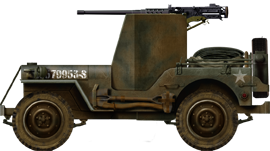
1/4 ton 4x4 truck armored, Belgium, winter 1944-45.
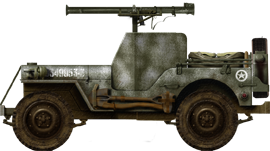
1/4 ton 4x4 truck armored, fast antitank squad, Belgium, January 1945.
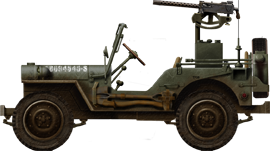
Radio Willys MB.
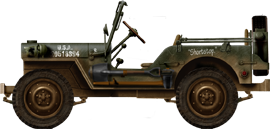
Willys MB, liaison vehicle.
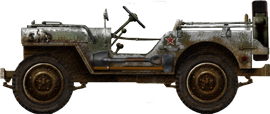
Soviet Ford GPW, Leningrad sector, winter 1943.
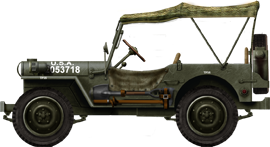
British MB Jeep with partial tarpaulin and canvas doors, Burma, 1945.
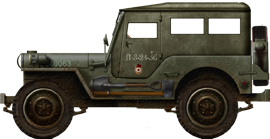
Russian Lend-Lease hardtop Ford GPW Jeep.
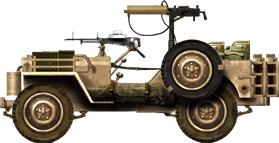
LRDG vehicle, Libyan desert, 1943.
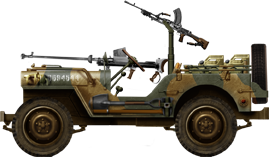
A British Willis MB in Italy, early 1944. Notice the Boys AT rifle and AA Bren gun.
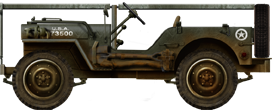
Jeep Willys MB Ambulance.

British Willys Jeep MB Tractor with 2 pdr gun (40 mm/1.57 in).

Willys MB with standard trailer.
Gallery
